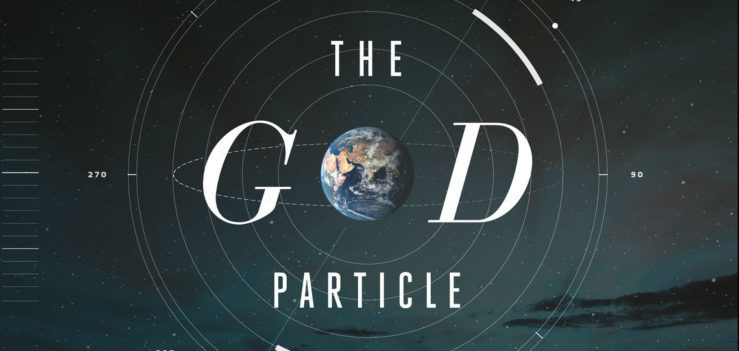It looks like you're using an Ad Blocker.
Please white-list or disable AboveTopSecret.com in your ad-blocking tool.
Thank you.
Some features of ATS will be disabled while you continue to use an ad-blocker.
share:
So it appears that the whole Universe is likely a String Singularity, and so therefore we posit "Unified Field Consciousness".
This is an inescapable and inevitable logical determination when all things are considered. It explains everything. It is the "Unified Field Theory" and it matches all great philosophical and religious teachings from our history. It is the ultimate revelation of Quantum Physics and Cosmology. It's the "Tao of Super Strings and Black Holes".
Only 1 particle exists, and from it emanates all things.
It's almost as if the Big Bang both did and did not happen simultaneously.
This "Divine Particle Wave" is self-aware, supra-conscious, and supra-sentient.
It is ever-present as the fundamental basis of reality, it is the substance of which all things are made.
Traditionally it is called "Spirit", but we can refer to it as various names such as "Consciousness".
Please watch these videos and listen carefully...
This thread was inspired by John Wheeler and his One-Electron Universe Theory proposed in 1940, along with all deep thinkers throughout human history that I draw upon.
This explains how a particle can be a wave and a wave can be a particle.
It explains quantum entanglement and superposition, light, ghosts, psychic phenomena, imagination and dreams, and even 'God'.
Everything is connected as Oneness.
This is an inescapable and inevitable logical determination when all things are considered. It explains everything. It is the "Unified Field Theory" and it matches all great philosophical and religious teachings from our history. It is the ultimate revelation of Quantum Physics and Cosmology. It's the "Tao of Super Strings and Black Holes".
Only 1 particle exists, and from it emanates all things.
It's almost as if the Big Bang both did and did not happen simultaneously.
This "Divine Particle Wave" is self-aware, supra-conscious, and supra-sentient.
It is ever-present as the fundamental basis of reality, it is the substance of which all things are made.
Traditionally it is called "Spirit", but we can refer to it as various names such as "Consciousness".
Please watch these videos and listen carefully...
John Hagelin is an American particle physicist. He has contributed to the development of unified field theory through his work at the European Organization for Nuclear Research (CERN) and the Stanford Linear Accelerator Center (SLAC).
This thread was inspired by John Wheeler and his One-Electron Universe Theory proposed in 1940, along with all deep thinkers throughout human history that I draw upon.
The one-electron universe postulate, proposed by John Wheeler in a telephone call to Richard Feynman in the spring of 1940, hypothesises that all electrons and positrons are actually manifestations of a single entity moving backwards and forwards in time.
According to Feynman: “ I received a telephone call one day at the graduate college at Princeton from Professor Wheeler, in which he said, "Feynman, I know why all electrons have the same charge and the same mass" "Why?" "Because, they are all the same electron!"[1]
This explains how a particle can be a wave and a wave can be a particle.
It explains quantum entanglement and superposition, light, ghosts, psychic phenomena, imagination and dreams, and even 'God'.
Everything is connected as Oneness.
edit on 3/16/2018 by muzzleflash because: (no reason given)
It is relevant to call this

the

It is...

the Higgs Boson never deserved that title.

the

It is...

the Higgs Boson never deserved that title.
a reply to: muzzleflash
This is super interesting, So every electron, even when there are groups of electrons, are all the same electron at different points in it's "lifespan"?
This is super interesting, So every electron, even when there are groups of electrons, are all the same electron at different points in it's "lifespan"?
originally posted by: PsychoEmperor
a reply to: muzzleflash
This is super interesting, So every electron, even when there are groups of electrons, are all the same electron at different points in it's "lifespan"?
Well in "Eternity" I'm sure there's plenty of time to cover all the bases, lol.
The most simple of symbols. Yet the less understood. The Circumpunct.
Ancients knew it.
Ancients knew it.
a reply to: muzzleflash
This is fascinating. The idea that all same particles are actually but one particle is so preposterous that I actually like it! Because if true, then it'd involve Time as an active participant in the very structure of the universe, instead of just being a direction.
The one particle idea also fits surprisingly well with my own scientific model, in which I demonstrate that all particles of the standard model could actually be composed of a single "master" particle, like DNA is composed of only a few bases.
The Singular Primordial Preon Theory on ATS
Also, involving time as a component of particles would confirm my theory that Time has 2 dimensions; and that the Grandfather Paradox is but a misunderstanding caused by our assumption that Time has only one dimension.
This is fascinating. The idea that all same particles are actually but one particle is so preposterous that I actually like it! Because if true, then it'd involve Time as an active participant in the very structure of the universe, instead of just being a direction.
The one particle idea also fits surprisingly well with my own scientific model, in which I demonstrate that all particles of the standard model could actually be composed of a single "master" particle, like DNA is composed of only a few bases.
The Singular Primordial Preon Theory on ATS
Also, involving time as a component of particles would confirm my theory that Time has 2 dimensions; and that the Grandfather Paradox is but a misunderstanding caused by our assumption that Time has only one dimension.
edit on 16-3-2018 by swanne because: (no reason given)
a reply to: PsychoEmperor
And so this was applied to antiparticle - particle pairs as well:
The idea is based on the world lines traced out across spacetime by every electron. Rather than have myriad such lines, Wheeler suggested that they could all be parts of one single line like a huge tangled knot, traced out by the one electron. Any given moment in time is represented by a slice across spacetime, and would meet the knotted line a great many times. Each such meeting point represents a real electron at that moment.
At those points, half the lines will be directed forward in time and half will have looped round and be directed backwards. Wheeler suggested that these backwards sections appeared as the antiparticle to the electron, the positron.
And so this was applied to antiparticle - particle pairs as well:
Yoichiro Nambu later applied it to all production and annihilation of particle-antiparticle pairs, stating that "the eventual creation and annihilation of pairs that may occur now and then is no creation or annihilation, but only a change of direction of moving particles, from past to future, or from future to past."[3]
edit on 3/16/2018 by muzzleflash because: (no reason given)
originally posted by: Abednego
The most simple of symbols. Yet the less understood. The Circumpunct.
Ancients knew it.
The Circle-Dot actually represents "Spirit" in various traditions, and as an extension it was also a symbol for "Gold" which is the final transmutation of alchemy and it also represents Ra the Sun in Egypt.
It also represents Monism aka "Oneness".
In Kabbalah it is the Sephirah 'Keter' the top/crown point of the Tree of Life:
Keter is so sublime, it is called in the Zohar "the most hidden of all hidden things", and is completely incomprehensible to man.
Now check this out:
The name of God associated with Keter is Ehyeh Asher Ehyeh (Hebrew: אהיה אשר אהיה), the name through which he revealed himself to Moses from the burning bush.[4] "It is from the name Ehyeh that all kinds of sustenance emanate, coming from the source, which is the infinite".
I Am That I Am
So this symbol actually describes how the entire Universe emanates out of this 1 point.
And since it's name is I AM than I guess it really is Consciousness.
Time is an invention of Man, a measurement. It serves no real purpose but to keep us accountable, and managed. It allows us to catalogue things, and
events in order but you don't really need time to do that.
If you remove time from the equation, what do you get?
If you remove time from the equation, what do you get?
originally posted by: Cygnis
Time is an invention of Man, a measurement. It serves no real purpose but to keep us accountable, and managed. It allows us to catalogue things, and events in order but you don't really need time to do that.
If you remove time from the equation, what do you get?
There is and there is not time. Paradox.
We are within "Eternal Now" but yet "Times they are a Changin"...
At least according to Bob Dylan.
The real question, though, is:
If every particles are one particle, as the OP proposes, and
If all species of particles are composed of a single master particle, and
If time can actually bend backwards so to provide multiple instances of the same particle,
Then,
What causes these lines to bend into such shapes? What forces acts upon the universe to affect literally space and time and weave it as if it was a mere thread into this complex tapestry?
If every particles are one particle, as the OP proposes, and
If all species of particles are composed of a single master particle, and
If time can actually bend backwards so to provide multiple instances of the same particle,
Then,
What causes these lines to bend into such shapes? What forces acts upon the universe to affect literally space and time and weave it as if it was a mere thread into this complex tapestry?
This also explains why CERN has this statue specifically...

This is the rear...

Look into how "Shiva, Vishnu, and Brahma" fit into the concept of Universal Oneness and Consciousness.

This is the rear...

Look into how "Shiva, Vishnu, and Brahma" fit into the concept of Universal Oneness and Consciousness.
originally posted by: muzzleflash
originally posted by: Cygnis
Time is an invention of Man, a measurement. It serves no real purpose but to keep us accountable, and managed. It allows us to catalogue things, and events in order but you don't really need time to do that.
If you remove time from the equation, what do you get?
There is and there is not time. Paradox.
We are within "Eternal Now" but yet "Times they are a Changin"...
At least according to Bob Dylan.
No paradox. Again the Circumpunct.
The outside circle is "time", always moving, always expanding. The point in the center has no time is still, never moving but watching in all directions. The outside circle is part of the point, they are one and two at the same time.
The Eye.
a reply to: muzzleflash
People who take '___' have been telling us this for years!
"I am he as you are he as you are me and we are all together." - I am the Walrus - The Beatles
Edit: Guess we can't use those three letters here
People who take '___' have been telling us this for years!
"I am he as you are he as you are me and we are all together." - I am the Walrus - The Beatles
Edit: Guess we can't use those three letters here
edit on 16-3-2018 by bluesjr because: (no reason given)
new topics
-
Sick sick sick
Other Current Events: 2 minutes ago -
Comcast dumping MSNBC
Mainstream News: 2 hours ago -
President-elect TRUMP Picks MATT GAETZ for his ATTORNEY GENERAL - High Level PANIC Ensues.
2024 Elections: 6 hours ago -
Mike Tyson returns 11-15-24
World Sports: 10 hours ago
top topics
-
Breaking: FBI Agents Raid Polymarket CEO After Betting Site Predicts Trump Win
General Conspiracies: 12 hours ago, 18 flags -
The Guardian quits Elon Musk's X social media platform
Mainstream News: 13 hours ago, 16 flags -
US warship Edsall Lost after Pearl Harbor Attack Found 80 Years Later ... by Accident
Mainstream News: 16 hours ago, 14 flags -
Thune selected as Senate Republican Leader
US Political Madness: 15 hours ago, 13 flags -
HHS Spent Hundreds of Millions of Dollars on DEI Initiatives Under Biden, Watchdog Finds
US Political Madness: 12 hours ago, 11 flags -
Band of Brothers 2001 Classic
Television: 15 hours ago, 7 flags -
President-elect TRUMP Picks MATT GAETZ for his ATTORNEY GENERAL - High Level PANIC Ensues.
2024 Elections: 6 hours ago, 7 flags -
Comcast dumping MSNBC
Mainstream News: 2 hours ago, 6 flags -
Mike Tyson returns 11-15-24
World Sports: 10 hours ago, 4 flags -
Sick sick sick
Other Current Events: 2 minutes ago, 0 flags
active topics
-
Sick sick sick
Other Current Events • 0 • : SprocketUK -
Elon's Starlink Stole The Election For Trump--Leftist Conspiracy Theorists Charge
General Conspiracies • 34 • : bastion -
WATCH LIVE: US Congress hearing on UFOs, unidentified anomalous phenomena
Aliens and UFOs • 35 • : Lazy88 -
Comcast dumping MSNBC
Mainstream News • 2 • : berbofthegreen -
Breaking: FBI Agents Raid Polymarket CEO After Betting Site Predicts Trump Win
General Conspiracies • 19 • : billxam1 -
How can you defend yourself when the police will not tell you what you did?
Posse Comitatus • 63 • : Freeborn -
60s-70s Psychedelia
Music • 52 • : Flyingclaydisk -
Mike Tyson returns 11-15-24
World Sports • 14 • : angelchemuel -
President-elect TRUMP Picks MATT GAETZ for his ATTORNEY GENERAL - High Level PANIC Ensues.
2024 Elections • 36 • : putnam6 -
Judge’s Dismissal of Classified Document Case Against Trump Explained
Other Current Events • 19 • : WeMustCare

